

High doses and prolonged use (CAMH, 2010):Īt high doses or prolonged use over a period of time (binges), these drugs cause paranoia, sleep deprivation, anxiety, heart palpitations, irritability, aggression, hallucinations, increased body temperature, muscle spasms, and possible strokes. When cocaine is used with alcohol, the liver produces cocaethylene, a powerful compound that increases the risk of overdose and sudden death beyond the risk of using cocaine alone. There is no antidote to cocaine overdose. It can cause breathing to become weak or stop altogether. Overdose can cause seizures and heart failure. At the same time, cocaine causes the heart muscle to work harder, which can lead to heart attack or stroke, even in healthy people.Ĭocaine raises blood pressure, which can cause weakened blood vessels in the brain to burst.Ī person can overdose on even a small amount of cocaine. Side effects and cautions Risks related to cocaine use (CAMH, 2010):Ĭocaine causes the blood vessels to thicken and constrict, reducing the flow of oxygen to the heart. Some people stay high by “bingeing,” or continually using the drug, for hours or days (CAMH, 2010). When the cocaine high fades, the person may begin to feel anxious and depressed, and have intense craving for more of the drug. Irritated respiratory system (when smoking) Effects include:įeeling ‘high’, sense of wellbeing, relaxation, and heightened sensory experiencesįeeling euphoric, talkative, giggly, and lively

The effects of using both cocaine and crack cocaine are that of euphoria, stimulating/energizing, suppression of fatigue, confidence, enhancement of sensory experiences (such as music, art or sexual encounters), increased sociability and suppression of appetite. Cocaine and heroin, mixed and dissolved for injection, is called a “speedball” (CAMH, 2010). The taste of the drug is felt through smoking, which causes both a warm and numbing sensation in the mouth and lungs.Ĭocaine is often used with other drugs, especially alcohol and cannabis. These forms, known as “freebase” and “crack,” look like crystals or small white/yellowish rocks. The base form of cocaine can be chemically processed to produce forms of cocaine that can be smoked. It has a bitter and numbing taste, which is specifically felt after snorting the drug, producing a very bitter flavour in the back of the user’s throat, known as “the drips”. If it is a purer form/hasn’t been cut with a lot of adulterants, it will have a slight shine to it, similar to that of fish scales. It is sometimes “cut,” or mixed, with things that look like it, such as cornstarch or talcum powder, or with other drugs, such as local anesthetics or amphetamines. Cocaine hydrochloride-the form in which cocaine is snorted or injected-is a white crystalline powder that looks similar to household products you would use in your kitchen, such as baking soda or flour.


 0 kommentar(er)
0 kommentar(er)
